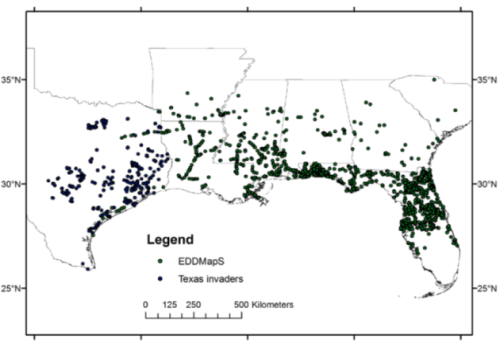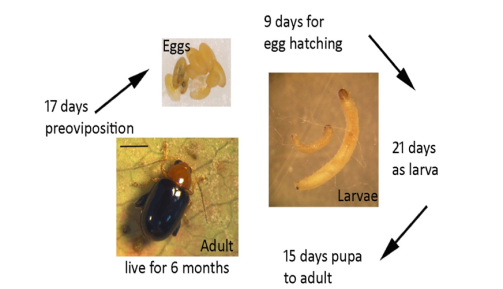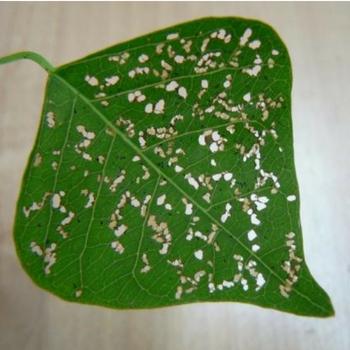Currently, a proposal developed by the U.S. Department of Agriculture (USDA), Animal and Plant Health Inspection Service (APHIS), Plant Protection and Quarantine (PPQ), Pests, Pathogens, and Biocontrol Permits (PPBP) is being reviewed to issue permits to release two insects, Bikasha collaris and Gadirtha fusca. These insects would be used as a biological control to manage the growth and spread of the Chinese tallow tree, Triadica sebifera. Beekeepers rely on tallow for a large part of their annual honey crop in central and north Florida, and it provides economic contribution through building honey bee brood, pollination services, and salaries.
Here is what beekeepers need to know.
The release of these insects is an attempt to reduce, but not eliminate, Chinese tallow. We anticipate no major change to honey production in the near-term. Tallow will not be eliminated as a nectar/pollen source for beekeepers, even in the long term because biological control agents have never completely eliminated their target. Any reductions in tallow populations would occur gradually, over five or more years.
- Native to China, tallow is considered one of the most aggressive and widespread weeds in the Southeastern United States. It is estimated to cover nearly 185,000 hectares of southern forests. In Florida, tallow is found primarily north of Orlando, Tampa, and Daytona Beach.
 Photo Credit: Dr. Gregory Wheeler, USDA
Photo Credit: Dr. Gregory Wheeler, USDA - Tallow is a large shrub/tree and can grow up to 60 feet tall. In the U.S., tallow is tolerant of many conditions, including shade, sun, drought, flood, freeze.
- A single tree can reproduce in three years and a mature tree can produce over 100,000 seeds per year.
- There are already other existing methods (chemical, physical, and mechanical) used to help control Chinese tallow. These methods can be costly, ineffective, and are known to provide only temporary solutions that may be harmful for non-target organisms.
- Although there are beneficial aspects for beekeepers, tallow also outcompetes useful honey bee nectar and pollen sources such as white tupelo (Nyssa ogeche), water tupelo (Nyssa aquatica), red maple (Acer rubrum), buttonbush (Cephalanthus occidentalis), buckwheat-tree (Cliftonia monophylla), willow (Salix spp.), elderberry (Sambucus sp.), dogwood (Cornus spp.), swamp cyrilla (Cyrilla racemiflora), loblolly-bay (Gordonia lasianthus), dahoon holly (Ilex cassine), inkberry/gallberry (Ilex glabra), yaupon holly (Ilex vomitoria), and fetterbush (Lyonia lucida).
- The insects being released will not kill the trees. They are expected to reduce tree vigor, reproductive output, and ability to spread.
- Any reductions in tallow populations would occur gradually, over five or more years. The gradual reduction would allow time for alternative, native nectar sources to recover or be planted by landowners, land managers, environmental groups, etc. During this time, landowners can apply for USDA conservation grants to replant native plants and reestablish natural communities.
- Bikasha collaris is a host-specific, natural enemy of Chinese tallow. It is a small flea beetle approximately 2 millimeters long. Eggs are laid in groups on the soil surface at the base of tallow, where the larvae feed on the roots of the plant. Adults feed on tallow leaves and young, woody stems. This species is unable to feed and sustain a population on other plants in North America.
Photo Credit: Dr. Gregory Wheeler, USDA
Photo Credit: Dr. Gregory Wheeler, USDA
9. Gadirtha fusca is another host-specific, natural enemy of Chinese tallow. It is a small moth about 2 centimeters long. Eggs are laid on leaves and larval feeding on leaves cause defoliation. The larvae develop through six instars, where defoliation occurs more extensively in the last three instars. This defoliation would reduce growth rate, plant height, and number of leaves. This species is unable to feed and sustain a population on other plants in North America.
 Photo Credit: Dr. Gregory Wheeler, USDA
Photo Credit: Dr. Gregory Wheeler, USDA Photo Credit: Dr. Gregory Wheeler, USDA
Photo Credit: Dr. Gregory Wheeler, USDA10. Globally, recent estimates for biological weed control programs have had an overall success rate of 65.7 percent.
11. In the western range of Chinese tallow, current estimates for surveillance and control exceed $10 million per year.
12. Return on investments for biological control of weed projects ranges from 12:1 to much greater. For example, biological control of waterhyacinth returned 34 times the original amount invested. It means that you should get $12-23 worth of host reduction effort for each dollar spent on discovery, testing, and propagation of a biological control agent. This uses the assumption that one dollar of chemical and labor for control = $1 of tree control.
13. Bikasha collaris and Gadirtha fusca are expected to impact seedlings only, not established plants.
Top: Bikasha collaris damage; Bottom: Gadirtha fusca damage are expected to impact seedlings only, not established plants. Photo Credit: Dr. Gregory Wheeler, USDA
For more information, visit the links below:
Invitation for public comment on the release of Bikasha collaris and Gadirtha fusca for Biological Control of Chinese Tallow
https://www.regulations.gov/document?D=APHIS-2020-0035-0001
Availability of an Environmental Assessment for biocontrol of Chinese tallow using Bikasha collaris sand Gadirtha fusca
https://beta.regulations.gov/docket/APHIS-2020-0035/document
Chinese Tallow- National Invasive Species Information Center
https://www.invasivespeciesinfo.gov/terrestrial/plants/chinese-tallow
Natural Area Weeds: Chinese Tallow (Sapium sebiferum L.)
https://edis.ifas.ufl.edu/pdffiles/AG/AG14800.pdf
Chinese Tallow- UF IFAS Gardening Solutions
https://gardeningsolutions.ifas.ufl.edu/care/weeds-and-invasive-plants/chinese-tallow.html
 1
1

 Photo Credit: Dr. Gregory Wheeler, USDA
Photo Credit: Dr. Gregory Wheeler, USDA Photo Credit: Dr. Gregory Wheeler, USDA
Photo Credit: Dr. Gregory Wheeler, USDA Photo Credit: Dr. Gregory Wheeler, USDA
Photo Credit: Dr. Gregory Wheeler, USDA Photo Credit: Dr. Gregory Wheeler, USDA
Photo Credit: Dr. Gregory Wheeler, USDA

